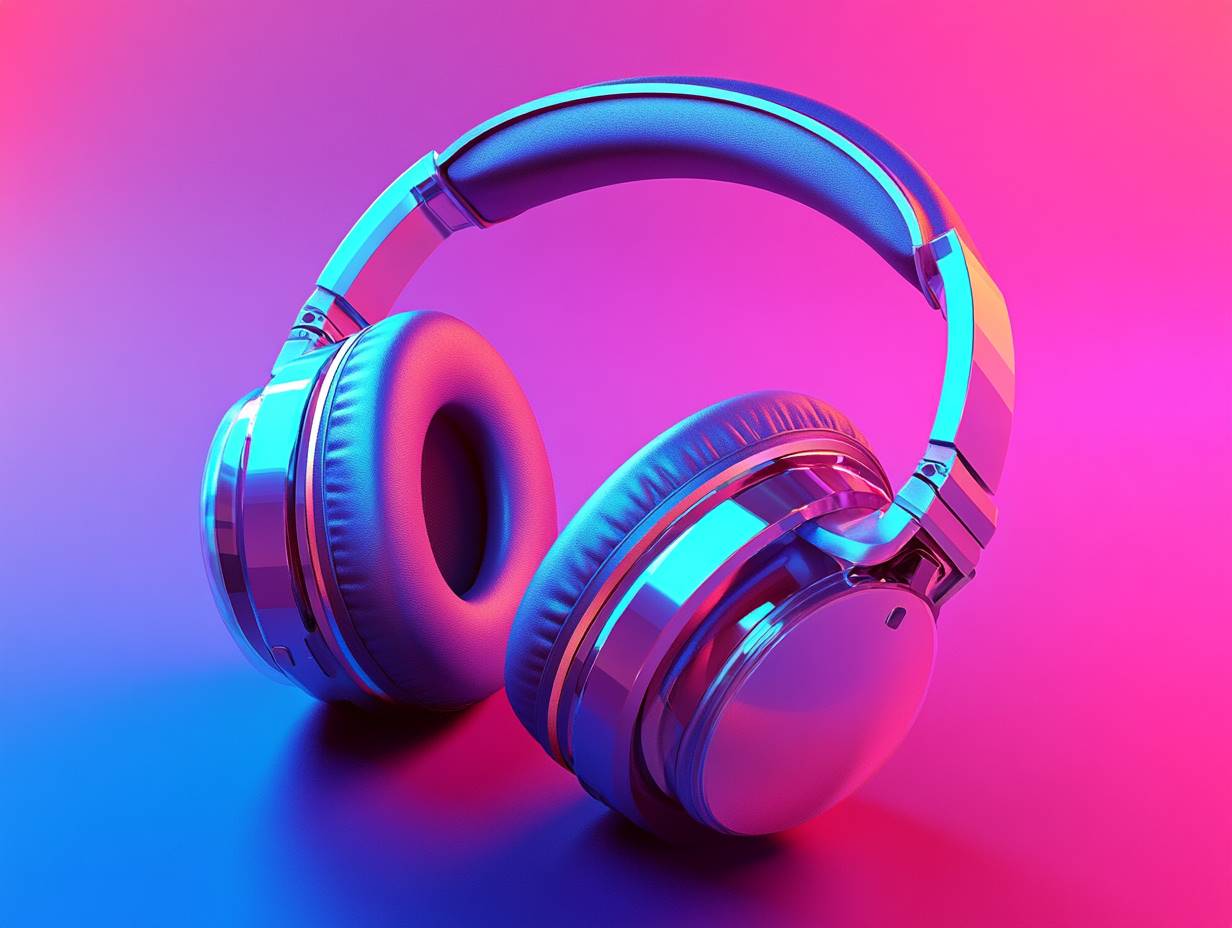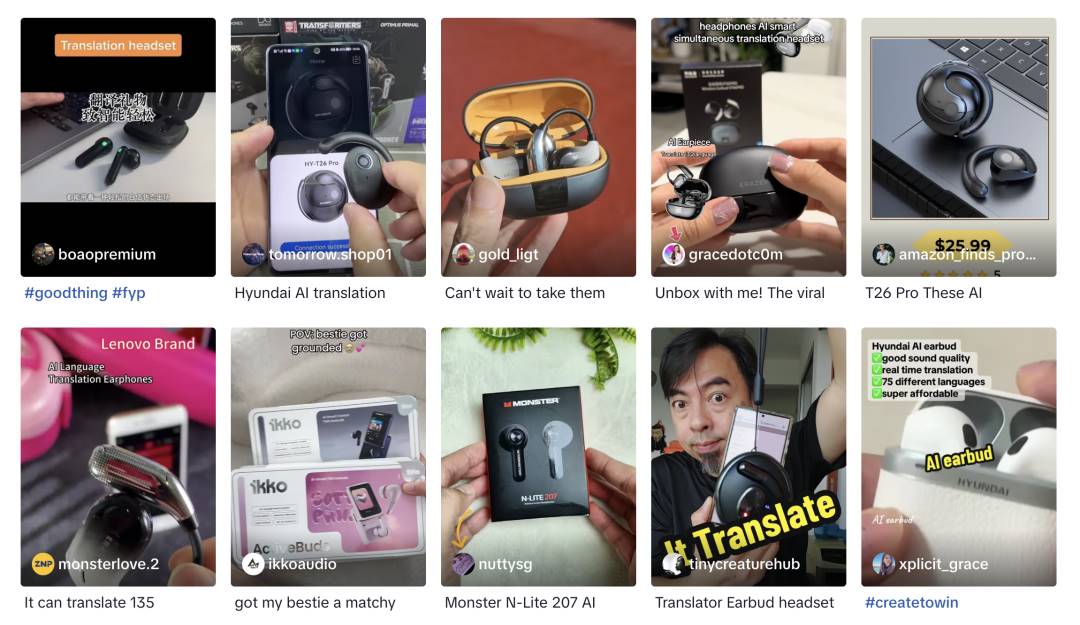We still underestimate the human need for communication.

Image source: Generated by Wujie AI
With AI integrated, Bluetooth headphones with translation functions have exploded in sales in the United States.
On TikTok, you can see various influencers recommending the $9.9 "translation headphones" to foreign consumers. Especially in the U.S., where AI innovation is most active, people are flocking to these so-called "AI-enabled" Bluetooth headphones.
Unsurprisingly, behind these "hot-selling" headphones are numerous Chinese startup teams, and even well-known companies like Miniso, joining the wave of "AI headphone" sales.
As AI becomes the biggest "politically correct" trend, large model companies are still pondering how to make money on the consumer side, while some have already sold new types of "AI hardware" like headphones globally, wildly "harvesting" the pockets of foreign consumers.
How did they do it? What do those foreign users placing frantic orders in live streams intend to do with these "AI headphones"?

Diverse AI translation headphone advertisements on TikTok | Image source: TikTok
01, "AI Headphones," Hot Overseas
"The translation headphones are selling out."
Zhang Zejie, head of NebulaBuds, which provides app solutions for Bluetooth headphones including translation and AI assistant features, told Geek Park that one of his Bluetooth headphone clients has monthly sales of around 2 million yuan on TikTok. After integrating AI assistant and translation functions into the headphone app, monthly sales skyrocketed to 8 million yuan.
A headphone OEM factory owner in Shenzhen also shared his observations: his partner, a small local team in Huaqiangbei, specializes in providing software solutions for small brands' Bluetooth headphones. At the beginning of 2024, they were struggling with payments of a few thousand yuan, but by the end of the year, they were driving luxury cars to negotiate business. He sighed, saying this is the "Huaqiangbei story" of ordinary people seizing an opportunity and making a fortune:
"In the past year, they were the lucky ones, making money too quickly."
The explosion in demand for translation headphones completely caught him off guard.
Among the clients Zhang Zejie serves are both small and medium brands as well as big names like Huawei and realme. The solutions provided by NebulaBuds mainly offer features like simultaneous interpretation, audio and video call translation, AI assistants, and noise cancellation through the app, rather than changing the hardware configuration of the headphones. Zhang Zejie explained: "Some of our clients had a lot of Bluetooth headphone inventory before, and after integrating our app, they could sell it overseas and successfully clear their stock."
Currently, the U.S. has become the largest sales destination for translation headphones, followed by the Middle East.
Zhang Zejie explained: "We originally thought that Americans would all speak English, but later found that there are a large number of Hispanic and other non-English speaking populations in the U.S. who need translation functions. The same goes for the Middle East. Additionally, there is market demand in Southeast Asia, India, and Europe, and surprisingly, Africa's purchasing power is even stronger than that of Southeast Asia."
"The market demand for AI translation functions has been steadily increasing, and our platform sees hundreds of thousands of activations each month," Zhang Zejie said.
Translation and AI functions have become the sales secret in the headphone market. An e-commerce seller of headphones also stated:
"As long as the AI features of the headphones are highlighted on e-commerce platforms, they almost always sell better."
During Black Friday in the U.S., the sales myth of translation headphones on TikTok seemed to confirm this trend: a certain translation headphone from Miniso sold over $2 million in 30 days; some digital stores sold translation headphones for around $30, generating $1.8 million in sales in a month, making it to the best-seller list.
Additionally, some TikTok influencers filmed short videos promoting translation headphones, earning $300,000 in sales commission.
"When I used to pitch our software solutions to headphone manufacturers, I would introduce specific features like AI and translation, but now I don't even mention those," Zhang Zejie said:
"Just one sentence: integrate it, and it will sell out."

We underestimated the demand for translation in areas with diverse immigrant populations | Image source: Visual China
02, Immigrant Groups, Buying AI Headphones in Droves
Through discussions with several headphone OEM factories, software solution providers, and headphone sellers, Geek Park found that the sudden explosion of translation headphones is partly due to precise marketing by sellers, but the core reason is that it meets the essential needs of diverse immigrant communities.
On TikTok, several typical scenarios in short video ads for headphone brands have garnered widespread attention. For example, Americans love going to nail salons and hair salons, where many technicians are Vietnamese immigrants. A short video sketch shows that after putting on translation headphones, customers can finally understand the conversations of the nail technicians.
One comment in the comment section also confirms the essential need of this scenario: "When you mentioned nails, hair, and translation, I was convinced in two seconds."
Another typical scenario is that taxi drivers need to serve passengers from different countries, and after wearing translation headphones, they can easily understand the passengers' languages.
These marketing scenarios indicate that in regions like Europe and the U.S., where immigrant populations are concentrated and cultures are diverse, the practicality of translation headphones is extremely high, yet this demand has not been fully explored and met before.
Moreover, the low price is also a core factor in the popularity of translation headphones.
The translation headphones sold by Miniso on TikTok are priced between $13.99 and $23.99, which converts to just over 100 yuan; some brands' translation headphones can drop to as low as $8.99 after discounts, significantly lowering the threshold for consumers to try them out.
A headphone seller found that headphones with more powerful AI features and better experiences generally cost one to two thousand yuan, but their sales were not ideal. The popularity of low-priced smart headphones actually confirms consumers' desire to try out AI features, but they need a lower threshold for experience.
From a technical perspective, the improvement in translation function experience due to large model technology is also a significant reason for the sales explosion. Zhang Zejie stated that after the wave of large model technology, voice recognition has become more accurate, and large models can help with calibration, making AI assistants no longer "dumb," but a truly usable feature. "After AI developed to the stage of chatGPT, compared to the era of smart speakers, where it either couldn't understand or couldn't respond, the usability of AI functions has greatly improved."
The explosion of translation headphones also has an undeniable larger context: the headphone market has been growing rapidly. Canalys data shows that in the third quarter of 2024, TWS headphone shipments reached 92.3 million units, a year-on-year increase of 15%, with Xiaomi and Huawei achieving over 50% annual growth in the global market. Among them, open-ear headphones have seen particularly rapid growth. IDC data shows that from January to August 2024, the open-ear headphone market shipped 16.36 million units, a year-on-year increase of 271.5%.

Ear-hook headphones are quite popular | Image source: TikTok
03, AI Implementation, Huaqiangbei Leads the Way
The hot sales of translation headphones reflect the enormous potential of using AI features as selling points.
The owner of an OEM factory in Huaqiangbei, which serves multiple headphone brands, found that in the second half of 2024, there have been no new breakthroughs in product forms or hardware technology for headphones for a long time, and the industry is shifting its focus to the app side of headphones, hoping to find new growth points and selling points. At this time, the emergence of the "AI concept" has perfectly aligned with the interests of many headphone manufacturers.
AI is stimulating new consumer demand, "Consumers are increasingly valuing the capabilities provided by headphone apps."
From the supply side, a new consensus is being reached: AI functions will become the most important growth point for headphones in the future. He revealed that in 2025, many headphone brands will focus on AI functions.

Huaqiangbei commercial area in Shenzhen | Image source: Visual China
Many industry insiders stated that the current wave of sales for AI translation headphones is also benefiting from the extensive promotion of AI capabilities by large companies and large model startups, which has effectively educated the market, and many users are gradually starting to engage with AI.
NebulaBuds currently integrates AI assistants like Doubao and DeepSeek domestically (and also integrates chatGPT overseas), and using the AI assistant in NebulaBuds requires payment. "Although Doubao has a separate free app, we found that many users are also very willing to use the Doubao assistant provided in our app, indicating that the demand for AI functions is real."
While tech entrepreneurs and investors from large companies debate the feasibility of AI hardware and whether it is sufficient, the bosses in Shenzhen are harvesting the global market with $8.99 headphones.
Zhang Zejie gave an example: before the Spring Festival, after DeepSeek became popular, "we spent the entire Spring Festival researching DeepSeek. Many clients for Bluetooth headphones and smartwatches were urging us to integrate DeepSeek features, and we realized we needed to integrate it too; it was a two-way street." It can be said that Shenzhen's hardware manufacturers are very quick to respond in product implementation and chasing new consumer trends.
On one hand, AGI needs idealistic technologists to explore the future; on the other hand, AGI also needs to be implemented, and the pragmatic "lucky ones" have already made money. The combination of technological ideals and commercial realities may be the best path for AI to enter the mass market.
免责声明:本文章仅代表作者个人观点,不代表本平台的立场和观点。本文章仅供信息分享,不构成对任何人的任何投资建议。用户与作者之间的任何争议,与本平台无关。如网页中刊载的文章或图片涉及侵权,请提供相关的权利证明和身份证明发送邮件到support@aicoin.com,本平台相关工作人员将会进行核查。




